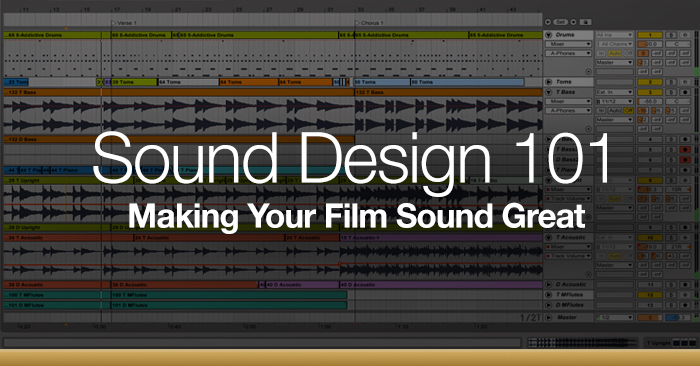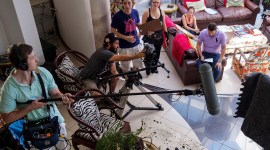
Sound Design 101: Making Your Film Sound Great
Obtaining solid sound design is essential to a film’s success. So what steps can you take to craft the best audio experience for your film project?
There are a few misconceptions when it comes to what sound design for film is, so let’s get that out of the way first…
- Sound design is not about assembling neat effects, loud gunshots or using a car crash SFX for every bang or crash in your film.
- It is not about having the loudest film.
Sound design is a process of experimentation to create an audio environment that supports the on-screen action and engages the audience. The true sound designer is constantly listening, learning and experimenting.
Getting a good mix starts with clean and healthy signals from your sound recordist and boom operator. The dialogue to your film is an essential part of what’s going to translate the pictures to your audience in an emotional direction.
So let’s dive in and explore the principals and techniques of obtaining a good mix for a film:
- Gain staging and Volume
- Compression
- EQ
- Reverb
Gain Staging And Volume
Proper gain staging is important to the fidelity and cohesiveness of your mix. As previously stated, obtaining clean and healthy signals for each track is perhaps the most important part of structuring a mix; as every decision you make from here on out is directly affected by your choices in gain staging.
As a quick aside, it’s important to capture wild tracks on-set when possible (audio intended to be synchronized later on). This will save you from a great deal of ADR in post production (a few extra minutes on set could save you countless hours later).
As you structure your mix, it’s imperative to create sonic depth for the picture. This is done by adjusting and fine-tuning each track’s dB control; creating a sonically rich and diverse atmosphere. You can further create depth and separation in your mix with the addition of reverb sends, but we’ll get to that later. This is where your mix should start to shine; before any compression, EQ or reverb effects have been used.
You generally want your master channel to be peaking around -15dB to -12dB in it’s loudest moments, as it’s important to leave plenty of headroom for mastering. Generally speaking, it’s better to reduce the volume of all the other tracks, rather than boost any one volume. Don’t be afraid to drastically reduce the volume of a track only to gradually bring it up again to find that “pocket” where it belongs. Personally, I find this method much easier than reducing the track’s dB starting at a high volume.
Compression
Applying compression to your dialogue tracks, as well as the rest of your mix, tends to be a subjective matter. So let’s explore that for a moment…
Most every engineer uses compression; with a few carving themselves into this niche (in what has become popular over the years). Compression, gating and expansion all represent the dynamics family of processors by altering the dynamic range of your signal. When squashing your signal into a narrowed dynamic range, the audio is better controlled: it will fit into your mix easier and appear to sound more full.
Most can attest to a threshold ratio somewhere between 2:1 and 6:1 with the attack and release set to fairly fast response times. Though again, there are no rules here. It is best to use one’s better judgement, and most importantly your ears, when determining how much compression to use.
If you have a dialogue track that has a fair amount of ambience noise that you cannot eradicate, you don’t want to use much compression. Because the compressor is “leveling out” the signal, all of that background noise will be boosted to an uncomfortably high noise floor. Yet another reason why it’s very important to have clean dialogue tracks from the get-go.
EQ
Before you begin equalizing your dialogue, soundtrack, or the entire mix, there are a few things to keep in mind about frequency ranges. To avoid a muddy mix, it’s important that each track’s sonic range of frequency is balanced to allow all audio components enough frequency space to breathe. See the image below for a more visual explanation (click for larger view):

Image from Waterline Media
The human voice generally sits smack in the middle of the frequency range. Therefore: you can cut the top and bottom of all the dialogue. A low-pass and high-pass filter is generally what you want to use. This eliminates all of the low and high frequencies that are not necessary for the human voice’s frequency spectrum: the low rumble of a your generator that perhaps was too close to the set, a big truck driving by, or even the movement of your boom operator’s fingers on his pole. To eliminate these cut below 100 Hz and above 10 KHz.
Always EQ the dialogue with the entire mix playing so that you’re not soloing the tracks and working in the dark. Otherwise this can create problems with dialogue clarity in the entire mix. Below are a few tips and tweaks when addressing your dialogue (reverse for opposite effect):
- Male fullness= Boost 120 Hz
- Female fullness= Boost 240 Hz
- General Dialogue= Boost 2.5KHz
- Nasally dialogue= Cut between 2 KHz – 4KHz
- Male sibilance= Cut between 4KHz – 6 KHz
- Female sibilance= Cut between 6KHz – 8KHz
- Increase vocal presence= Boost 5KHz
Reverb
Early reflections to the human voice can contribute a great deal of presence and realism that EQ simply cannot recreate. Placing the dialogue in the correct acoustical space is a crucial element to obtaining good sound design and a solid mix. This is especially true for ADR work.
Because of the different types of reverbs and effects, the decisions you make creating your acoustical space will vary drastically from each scene, person, and the placement of your actor in relation to the camera angle. For example, your actor may be speaking directly at the camera, then completely turn his/her back to the camera speaking into the distance. Remember, the camera is the audience’s point of view.
So, how would you best demonstrate this in your mix? Usually by automating the volume, reverb, and low-pass filter to the desired effect. EQ is your friend here too. But again, there are no rules. Generally, you want a far-sounding verb and a near-sounding verb on your reverb busses to obtain the correct atmospheric mix.
Summary
We take in a huge variety of noises and sounds in our everyday lives. The sound designer is always taking advantage of these opportunities, consistently thinking outside the box. They are continually scheming and searching for the best way to create engaging soundscapes through experimentation.
Need music for your film or video projects? Check out our curated royalty free music library.







